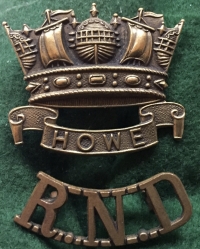







 [BIOGRAPHY]
Patrick Ryan was an Irishman from Limerick who was born on 9th March 1888. Described throughout his service papers as a “Fisherman”, he also served as a merchant seaman in SS LUSITANIA on at least one voyage between Liverpool & New York.
He apparently deserted the ship when he got back to Liverpool in November 1911.
He is next shown in service with the R.N.R. in May of 1912 and is again described as being a Fisherman.
[BIOGRAPHY]
Patrick Ryan was an Irishman from Limerick who was born on 9th March 1888. Described throughout his service papers as a “Fisherman”, he also served as a merchant seaman in SS LUSITANIA on at least one voyage between Liverpool & New York.
He apparently deserted the ship when he got back to Liverpool in November 1911.
He is next shown in service with the R.N.R. in May of 1912 and is again described as being a Fisherman.

 He clearly took part in the Siege of Antwerp in early October 1914 as he is at that time recorded as serving in Belgium with the Howe Battalion R.N.D. in October 1914.
He clearly took part in the Siege of Antwerp in early October 1914 as he is at that time recorded as serving in Belgium with the Howe Battalion R.N.D. in October 1914.
 The Howe Battalion trenches were situated in the middle of a churchyard and the men were in the trenches for two days and two nights, from Tuesday to Thursday. In the course of the fighting the bombardment was so terrific that some of the men were driven out of their minds by it.
The German artillery was very accurate, and deadly for the most part. When the Naval Brigade first took to the trenches, the German shells did not touch them, but soon one of the enemy aeroplanes appeared overhead, and within ten minutes the trenches were raked with a terrible fire.
A great deal of difficulty was experienced because the Germans drove the Belgian refugees before them as a shield, and the Naval Brigade had to avoid shooting them, although the Germans continued to fire at the men in the trenches.
The Howe Battalion trenches were situated in the middle of a churchyard and the men were in the trenches for two days and two nights, from Tuesday to Thursday. In the course of the fighting the bombardment was so terrific that some of the men were driven out of their minds by it.
The German artillery was very accurate, and deadly for the most part. When the Naval Brigade first took to the trenches, the German shells did not touch them, but soon one of the enemy aeroplanes appeared overhead, and within ten minutes the trenches were raked with a terrible fire.
A great deal of difficulty was experienced because the Germans drove the Belgian refugees before them as a shield, and the Naval Brigade had to avoid shooting them, although the Germans continued to fire at the men in the trenches.
 The lack of artillery was responsible for the retirement of the British force. It was simply a case of rifles against hundreds of German guns. It was observed that if they had killed two Germans to every one Englishman, there would have been plenty of the enemy left to march to Antwerp, so at last they had to retire. The retreat from Antwerp was full of peril and incident. The Naval Brigade had to pass between blazing tanks of petrol, over a river on a pontoon bridge. It was certainly not an orderly retreat, because they had to get out as fast as they could.
On the 7th the Marine Brigade was withdrawn to the line of inner forts. The Marines defended this position until the conditions on which we could remain were no longer being fulfilled.
“A final decision was made on the 8th of October by Mr Winston Churchill (the First Lord) to retreat to the coast." Charles James Black, RMLI.
The lack of artillery was responsible for the retirement of the British force. It was simply a case of rifles against hundreds of German guns. It was observed that if they had killed two Germans to every one Englishman, there would have been plenty of the enemy left to march to Antwerp, so at last they had to retire. The retreat from Antwerp was full of peril and incident. The Naval Brigade had to pass between blazing tanks of petrol, over a river on a pontoon bridge. It was certainly not an orderly retreat, because they had to get out as fast as they could.
On the 7th the Marine Brigade was withdrawn to the line of inner forts. The Marines defended this position until the conditions on which we could remain were no longer being fulfilled.
“A final decision was made on the 8th of October by Mr Winston Churchill (the First Lord) to retreat to the coast." Charles James Black, RMLI.


 Pat Ryan is shown as being discharged in July 1919 at Limerick, Joseph's next address was *2 Shaw’s Brow, Douglas, Isle of Man. (*The address still exists and is just one road back from the harbour at Douglas.)
An extremely desirable “Howe” RND 1914 Star & Bar Trio to the much sought after Royal Naval Division.
£695 (With Full Service Papers and an original Howe Bn Cap Badge & Collar Dog)
Pat Ryan is shown as being discharged in July 1919 at Limerick, Joseph's next address was *2 Shaw’s Brow, Douglas, Isle of Man. (*The address still exists and is just one road back from the harbour at Douglas.)
An extremely desirable “Howe” RND 1914 Star & Bar Trio to the much sought after Royal Naval Division.
£695 (With Full Service Papers and an original Howe Bn Cap Badge & Collar Dog)